#Ma dalton
Text
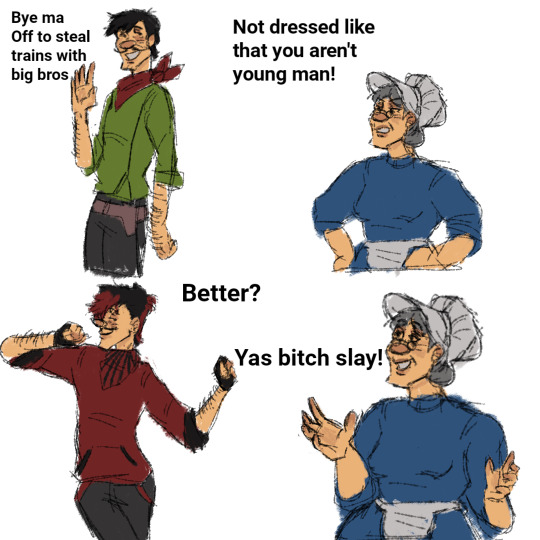
So I was searching for some lucky luke/Daltons reference on Google and found this 2015 deviant art of Averell:
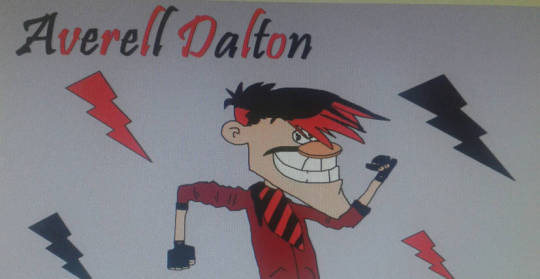
Immediately thought of this meme to draw it with, the drawing is pretty dope but sadly couldn't find the artist name so if you recognised 'em tell me.
#my art#lucky luke#les dalton#ma dalton#averell dalton#the daltons#He rocks with any outfit!!#yas bitch slay#fanart#Meme#The drawing looks so rushed forgive me
76 notes
·
View notes
Text


Goscinny's little men and their momma. :')
#astérix#lucky luke#joe dalton#praline#ma dalton#René goscinny#albert uderzo#morris#franco-belgian comics#bandes dessinées
82 notes
·
View notes
Text

73 notes
·
View notes
Text
Ma Dalton: Can you do me a favour?
Joe: I would literally cover up a murder you committed, plant my DNA at the crime scene and take the blame for you
Ma Dalton: Great. Can you do the dishes?
Joe: No.
7 notes
·
View notes
Text
Everyone who loves The Daltons should follow highchaparralsweden on Instagram. It’s a Wild West theme park in south Sweden with a few known Wild West characters, among them Lucky Luke and the Dalton family. There are a few really funny Dalton-sketches there (although in Swedish. Sorry to everyone who don’t know Swedish, but they are probably funny anyway).
I was there a few years ago and had a blast! I met Luke and the Daltons and I gave Averell a sweet! The best thing tho was overhearing a few kids trying to explain to Joe what TikTok was and Joe misunderstanding them the whole time
Link to their Instagram
#the daltons#averell dalton#les dalton#lucky luke#lucky luke daltons#the dalton brothers#dalton brothers#dalton family#the dalton family#joe dalton#william dalton#jack dalton#Ma dalton#high chaparral#high chaparral Sweden#highchaparralsweden#theme park#western#wild west
9 notes
·
View notes
Note
Headcanons on what Ma Dalton embarrassing her sons with?
It came out of nowhere, but I take it XD.
Let's see...
Ma Dalton is obviously favoring Averell over her other sons, since he’s the youngest. I imagine her being overprotective towards him, but he likes it and doesn’t mind being showered with affection whenever Ma visits them or they are visiting her.
However....
Joe, Jack and William do mind because every time when Averell is snitching at them for being mean to him, Ma goes into full-blown mom mode.
For the sake of additional realism (and hilarity) I present you with a following headcanon: Ma Dalton named her sons after famous criminals and so when she does the “kid being in trouble and therefore called by their full name” it looks like this:
“Jack the Ripper Dalton! What is it that I hear about you leaving your brother with a girl?! You know that he’s not old enough to be interested in women! And so do you! You’re grounded!”
“William Brodie Dalton! Why did you ruin my little Averell’s sculpture! Come here,I need to cane your bottocks!”
(I do not know who Joe might be named after, but you bet he gets called out and punished the most.)
In A Dad for Daltons we’ve had a scene where Joe got cold because he fell into the well. The next day when Ma saw his state she said: “I will give you nice suppository later.” So I guess sometimes she talks about things like that, but she’s sensible enough and cares about Dalton reputation enough to not do this in public...
Still she does consider Luke as part of the family so she has no qualms about talking about suppositories, melting over Averell, pinching and hugging, and occasionally disciplining her sons in front of their “worst enemy”. Joe is angry about it and embarrassed the most, while Jack and William try to salvage the situation.
12 notes
·
View notes
Text
Pa Dalton
Une des rares choses qu'on sait de lui, c'est que c'était un maître du forçage de coffre-fort.

Mais un très mauvais artificier.

L'humour de Jack ne s'en est toujours pas remis.
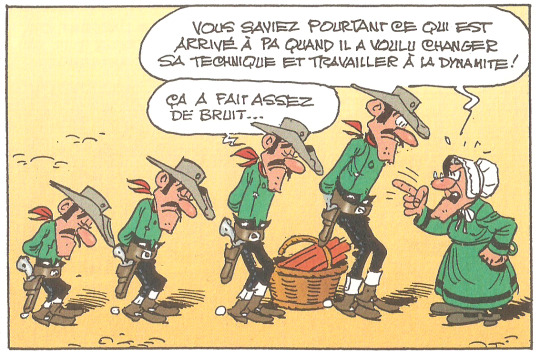
#non sérieusement j'adore Jack#il a un humour souvent très noir#et pince-sans-rire#mais il y a des limites tout de même XD!#les daltons#joe dalton#william dalton#jack dalton#averell dalton#ma dalton#pa dalton#Album : ma dalton#Album : Belle Stars#lucky luke
11 notes
·
View notes
Text
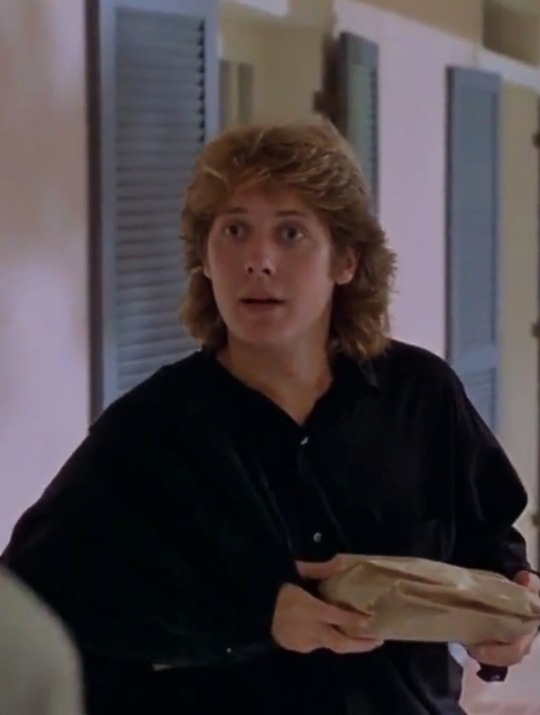



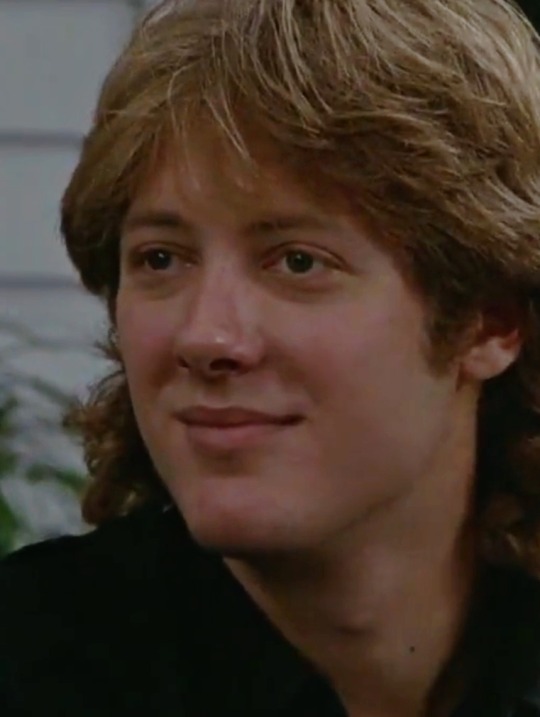
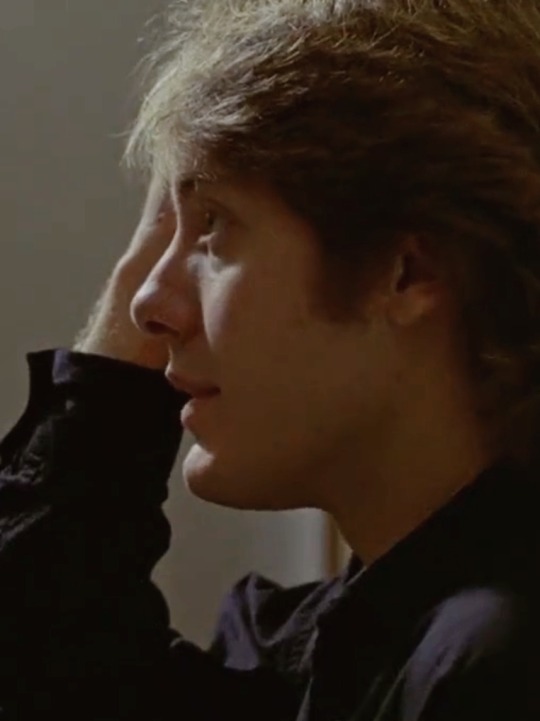
I WANT HIM NOW literally CRAVING HIM 💕
#james spader#graham dalton#sex lies and videotape#he is soooo perfect to me you dont even know#i need to worship his body so good and make him feel as if he was reborn#his voice I CANT STRESS THIS ENOUGH his VOICE is so fucking sexy in this movie it made me fucking wild#this boy is ma sexy boy#he is so pretty such a pretty boy#need to call him a good boy and see him moan near to my ear#his hair is suuuper beautiful in this one looks super soffft!!!#i am fuckn obsessed with him#crazy about him
33 notes
·
View notes
Text
I don't know if someone already did it but I don't care loll
neil, pitts, keating: looks like a cinnamon roll, is a cinnamon roll
todd, meeks: looks like a cinnamon roll, could kill you
charlie, knox: looks like could kill you, is actually a cinnamon roll
cameron: looks like could kill you, could actually kill you
#I feel like knox at the beginning of every interaction with stranger is 'ew wtf are you get away from me you plebeian'#but then you know him better and he's a sweetie#(take this as you want you can choose between fanon knox or canon knox)#also wanted to include keating#ma babygirl#dead poets society#dps fandom#dead poets headcanons#neil perry#todd anderson#charlie dalton#stephen meeks#gerard pitts#richard cameron#knox overstreet#john keating
81 notes
·
View notes
Note
I’m transmasc and trying to find a new name for myself, what names do you like?
romeo, dane, philo, grant/granville, sawyer, dalton, arlo, morrison, jonah, simon, calvin, samuel, cain, west/wesley, tyson, walker
#went & asked ma for some suggestions. her favs are dane + samuel. im very fond of dalton + granville#anonymous
106 notes
·
View notes
Text
MacGyver
Watching MacGyver again and just got to season 3.... let me just say, season 3 Mac is on another level of hotness
2 notes
·
View notes
Photo

A Lucky Luke Adventure: Ma Dalton
43 notes
·
View notes
Text

"Welton Academy, hello. Yes, he is. Just a moment. Mr. Nolan, it's for you. It's God. He says we should have girls at Welton."
#the dead poets society#Charlie Dalton#nuwanda#No me gustó tanto como salió este#pero lo tengo ahi salvado por como un mes entero o mas y lo quieria terminar#entonces este es el resultado final#Mira esas manos! Qué he hecho?#dps fanart#dps
5 notes
·
View notes
Text
Ma Dalton: Is there anyone here who’s actually straight?
Jack: *raises hand*
William: liar
#lucky luke#the daltons#Ma realizing that all of her 4 sons are gay and there is no hope for grandkids#incorrect lucky luke quotes
9 notes
·
View notes
Text
"He was never married": The story of John H. Packard, the papermaker [Part 1]

Three brothers (John and Charles Packard, RBM II), c. 1940. Likely in Plainfield. Colorized on Sept. 28, 2022 using Ancestry.com tools.
On October 15, 1882, John Henry Packard was born in Plainfield, Massachusetts to a farmer named Cyrus Winfield Packard (1852-1924) and former teacher, and shirtwaste worker, named Dorothy "Dora" Ann Mills (1849-1895). [1] He was an only child at the time of this birth. Over the years, he would have three brothers: Joseph Winfield (1885-1910), Charles Edward (1887-1960), and Robert (1891-1956) [adopted in 1895 by the Mills family]. He would also have 3 sisters: Margaret (1884-1976), Marion Estelle (1889-1965), and Mabel Hattie (1892-1961).
By 1900, he would be living in Plainfield with his father, Cyrus, his siblings, and Clementine, the second wife of Cyrus. He would be a farm laborer. [2] By 1918, he would work at George W. Sears in Windsor, Massachusetts as a farmer. A few years later, in 1920, he would be a papermaker working at a papermill and said to be the brother-in-law of Edwin A. Jordan, head of the household. Through the 1920s, he would be living in Berkshire, Massachusetts, again working at Pioneer Mill. By 1930 he would be lodging in Dalton in the Pierce household and as inspector at the paper mill. In the later 1930s he would again be working at Pioneer Mill and likely by 1940 when he was a boarder in a household led by Mary L. Munch. He would continue to work at the same location through the 1940s. By 1950 he would still be living in Dalton and lodger in the Cassidy household, working as a sweeper at paper mill. [3]
The latter was confirmed by the act that in 1949, he was identified as living in Dalton. He would die on October 28, 1950 of cirrhosis of the liver and noted as single. [4] The same had been stated in the 1950 census which stated that he never married. There is more about John than this, however. Part of that involves where he lived. In 1918 he was seemingly still living in Plainfield, [5] perhaps near where he lived in 1900, on High Street. He would also live in these locations through the rest of his life, all in Dalton, Massachusetts, a town said to be a "transition town between the urban and rural portions of Berkshire County":

Created using Google Earth Pro. Added pins by myself on September 27, 2022. I think "Bartonville" where he was in listed as living in 1926 and 1929 is likely Barton Hill Road. [6]
His obituary noted that he lived in Dalton for 32 years (1918-1950), and employed at Crane & Company and a member of the Dalton Congregational Church. In a weird twist of fate, he lived his last four months in Heath (where his brother Charles Edward was likely living), died at the Franklin County hospital in Greenfield, had his funeral at the Smith funeral home in Shelburne Falls, and was buried in West Hill Cemetery. Heath was a town that was a 30-40 miles away from Dalton, depending on which route you took, while Greenfield was even farther, at most fifty miles away and Shelburne Falls was 34-38 miles away depending on the route taken. However, where he is buried makes some sense. As it turns out, West Hill Cemetery, was only about 15 miles away.
Where John worked is now known as the Crane Museum of Papermaking, meant to care for, collect, and exhibit history of Crane Currency in order to "create an entertaining and educational experience of Crane Currency’s unique story" and papermaking itself. Since 1879, the Crane Company has supplied "banknote paper for United States currency." His role as a papermaker is akin to someone working at Westinghouse as an engineer in Pittsburgh as it is a similar situation in that one company was the main employer of the town. He worked at the Pioneer Mill, for which there as a parade in 1924, which he was likely a part of. That mill is at the current location of the Crane Museum, as confirmed by a nomination form for the National Registry for Historic Places in 1977. While he worked at the company, it was still run by the Crane family.
His time in Dalton is still generally a mystery, while historic photographs from the town's Historical Commission do not show him, local history books like A Bicentennial History of Dalton, Massachusetts 1784-1984 by Bernard A. Drew seem a bit expensive. Papermaking is said to be a big part of the Housatonic Valley region, even turning the southern Berkshires into "the center of the country’s paper industry" by the 1840s. It was also a key part of towns near Dalton, like Lee.
A deeper dive into the censuses reveals something: those he lived with also were listed as papermakers and undoubtedly also at Crane. For example, in 1920, he was living with Edwin A. Jordan, and his wife Fannie F., with both listed as papermakers. The household next to them, headed by Charles F. Dunham was the same way. On the same page John appears on, there are many others working at the paper mill. [7] While many of these families are have a typical nuclear family with a husband, wife, and children, some are households led by women, like those led by 34-year-old Bertha Greene, 47-year-old Elizebeth Marshall, or 31-year-old Rose Orten. The vast majority of those living there, on this one page, were born in Massachusetts, while some are from England, Pennsylvania, Ireland, Canada, or New York.
By 1930, the situation was relatively the same. The household John was staying in was headed by a man who was also an inspector at the papermill. In that same household, his wife, Harriet was a janitor, while a fellow 72-year-old Irish lodger, Rhoda Peterson, was also an inspector at the same place. On that page were listed an inspector at a woolen mill (46-year-old Patrick J. Enright), a sorter at the papermill (45-year-old Mary T. Gaffney), and a papermaker at the same place (44-year-old Cora M. Sherman). By 1940, he was the only person working at the papermill in the place he where he was lodging, but there were others nearby who worked there, like 35-year-old George A. Mongue and his 33-year-old wife Maguerite, 22-year-old James Fraley, 54-year-old Katherine Callahan, 61-year-old Frank J. Yates, and 68-year-old Catherine White. The same would be the case in 1950, when the head of the household, 63-year-old Frank Cassidy, was a guard at the paper mill, while Frank's 65-year-old daughter, Margaret, was a clerk there. On the same page is a 31-year-old sorter named Catherine Mongue an 18-year-old file clerk named Clara L. Brophy who were both listed as working at the papermill as well, along with a person who seemed to assemble parts at a woolen mill, 32-year-old Charles E. LaChurch.
My original aim of this post was propose that John may be gay since he lived his whole life and never married. As Michael J. Leclerc writes, as I noted in my post last month, "common signs of LGBTQ+ people are those who never married, or who married late in life or had no children" with the caveat the "these facts alone are not proof" and that additional signs are needed. However, it is hard to say for sure, even as Massachusetts is currently one of the most LGBTQ-friendly states, and has a large population of LGBTQ people today, especially in Suffolk, Hampshire and Franklin Counties. Dalton is in Berkshire County, with one of the lowest percentages of LGBTQ people. [8] Of course, these are current numbers, and there was no accounting in surveys of who was LGBTQ in Massachusetts during the time he lived there, from 1918 to 1950, so it is hard to know how many LGBTQ people were in Dalton during that period. After all, the so-called "getaway" for LGBTQ people in Western Massachusetts is Northampton, which is 36 to 42 miles away from Dalton, depending on the route taken. Only recently has the LGBT Chamber of Commerce expanded to Western Massachusetts, an area dubbed the "land of many rainbows" for older adults in 2017, as people move out of cities and to rural areas as prices in cities continue to climb. [9]
Before coming to a firm conclusion, I'd like to look at the censuses where he appeared again. Edwin A. Jordan, head of the household who lived with in 1920, died later that year. Edwin, who was married to a woman named Fannie as I noted earlier, was said to be John's brother-in-law, with no one else in the household. Something similar happened in 1930. In the census that year, Herbert Pierce, who headed the household where he lived, died in 1935. Pierce was married to Harriet Whitney. There were no other men in the household, as everyone else were women, either related to Herbert, his wife, or were lodgers. [10] By 1940 he was living in a household headed by a widowed landlady, Mary L. Munch. There were various single men in the household. This included a 37-year-old man named James Leland Fitzgibbons, who is noted as never marrying in the 1950 census, and also confirmed by the 1930 census. [11] There was also a 52-year-old man named Albert Cleo Maynard who was then-single. Albert would marry a woman named Mary Tubbs (1880-1964) in 1947, who would die in 1959, while Mary died many years later. By 1950, John was living in a household with no men apart from the head of the household, 62-year-old Frank Cassidy, who was married to a 58-year-old woman, Lidia E., and had a 25-year-old daughter named Margaret.

From Page 13 of aforementioned nomination form for the National Registry for Historic Places in 1977. John worked at the Pioneer Mill
So, in sum, there is not enough information, at this current time, to say that John was gay. Instead, all we can say, with definite certainty, that John was unmarried his entire life and worked at a paper mill for most of that time, from 1918 to 1950, since he moved from place to place across Dalton during his time there. Otherwise, his life will remain a bit of a mystery, although not as much as brother who was killed by a train in Nebraska.
Note: This was originally posted on July 10, 2023 on the main Packed with Packards WordPress blog (it can also be found on the Wayback Machine here). My research is still ongoing, so some conclusions in this piece may change in the future.
© 2023 Burkely Hermann. All rights reserved.
#colorized#plainfield#massachusetts#packards#family history#genealogy#genealogy research#dalton#plainfield ma#paper mills#20th century
0 notes
Text
How to annoy my mum:
Show her a picture of Ma Dalton from her comics and say “Haha look that’s you!”. For example: sneezing loudly, always having her special handbag with her, doting on her favourite cat and so on :)
5 notes
·
View notes